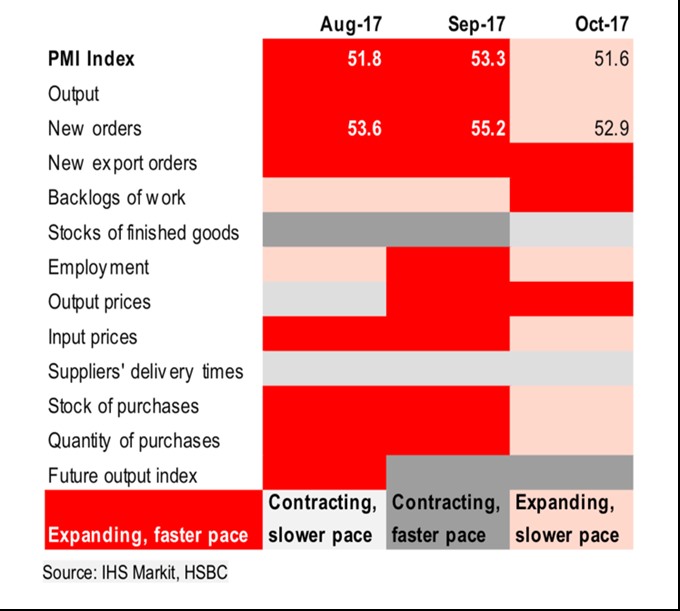 Economy
Economy

Crude oil’s days of being a major contributor to national economic growth are over, according to a report prepared by the Hongkong and Shanghai Banking Corporation Limited (HSBC).
 |
| October PMI expanded a slower pace. — Photo in the report |
HÀ NỘI — Crude oil’s days of being a major contributor to national economic growth are over, according to a report prepared by the Hongkong and Shanghai Banking Corporation Limited (HSBC).
The “Out with oil, in with tourism” report released on Wednesday says Việt Nam’s crude oil output as of September is estimated at 1.06 million tonnes, down 9.9 per cent compared to the same period last year and 11 per cent on a year to date (YTD) basis.
The country is looking for new growth channels amidst falling crude oil production. Deputy Prime Minister Vương Đình Huệ had said on October 24 in a meeting with legislators.
He said crude oil production would fall about three million metric tonnes in 2017, equivalent to a 0.75 per cent drop in GDP.
However, he also noted that tourism and related services could make up for the drop, given the sector’s growing share of the economy.
Over the past five years, Việt Nam’s exports have been primarily driven by a rapid growth in electronics and mobile phone shipments, drastically different from the previous decade (2000-10), when crude oil exports were a significant driver of exports growth, in addition to textiles and other goods like agricultural produce and products.
GDP growth and PMI
According to international economic and market analysts consulting firm IHS Markit, whose work is cited by the HSBC report, Việt Nam’s GDP growth is expected to reach 6.6 per cent this year and 6.4 per cent in 2018.
It evaluates Việt Nam’s export performance as being good at the moment. October exports increased 26.2 per cent compared to the same period last year, marking the third consecutive month of growth over 20 per cent. In addition, exports of telephones and spare parts continued to rise sharply, a year-on-year increase of 76 per cent.
Imports of electronic items including input components for telephones and other electronic items for export have also grown rapidly. Meanwhile, Việt Nam’s manufacturing sector has sustained its contribution to GDP growth since the beginning of the year and this tendency is set to continue.
However, the Purchasing Managers Index (PMI) fell to 51.6 in October from 53.3 in September. This was partly due to lower output and new orders. In particular, production has grown at the slowest pace since October 2016. But output and new orders will continue to increase despite being lower than September figures. Thus, growth in Việt Nam will remain strong until the end of the year despite the slight decline in production and exports at this time.
Meanwhile, October inflation rate is still in line with expectations, but there is a lot of risk due to recent oil price volatility. The full-year Consumer Price Index (CPI) rose 3 per cent from the same period last year, in line with HSBC expectations of 3.1 per cent, keeping inflation in line with the central bank’s target of keep it below 4 per cent this year. Inflation for the year is forecast at 3.5 per cent.
As in the previous month, the cost of healthcare has been a major factor in the price increase as the Government continues to reform its subsidy programmes. It should be noted that the recent rise in oil prices has put a high risk of inflation up until the end of the year. However, a slight increase in oil prices will keep inflation within the central bank’s target. HSBC forecasts inflation will remain 3.5 per cent in 2018, too. — VNS




